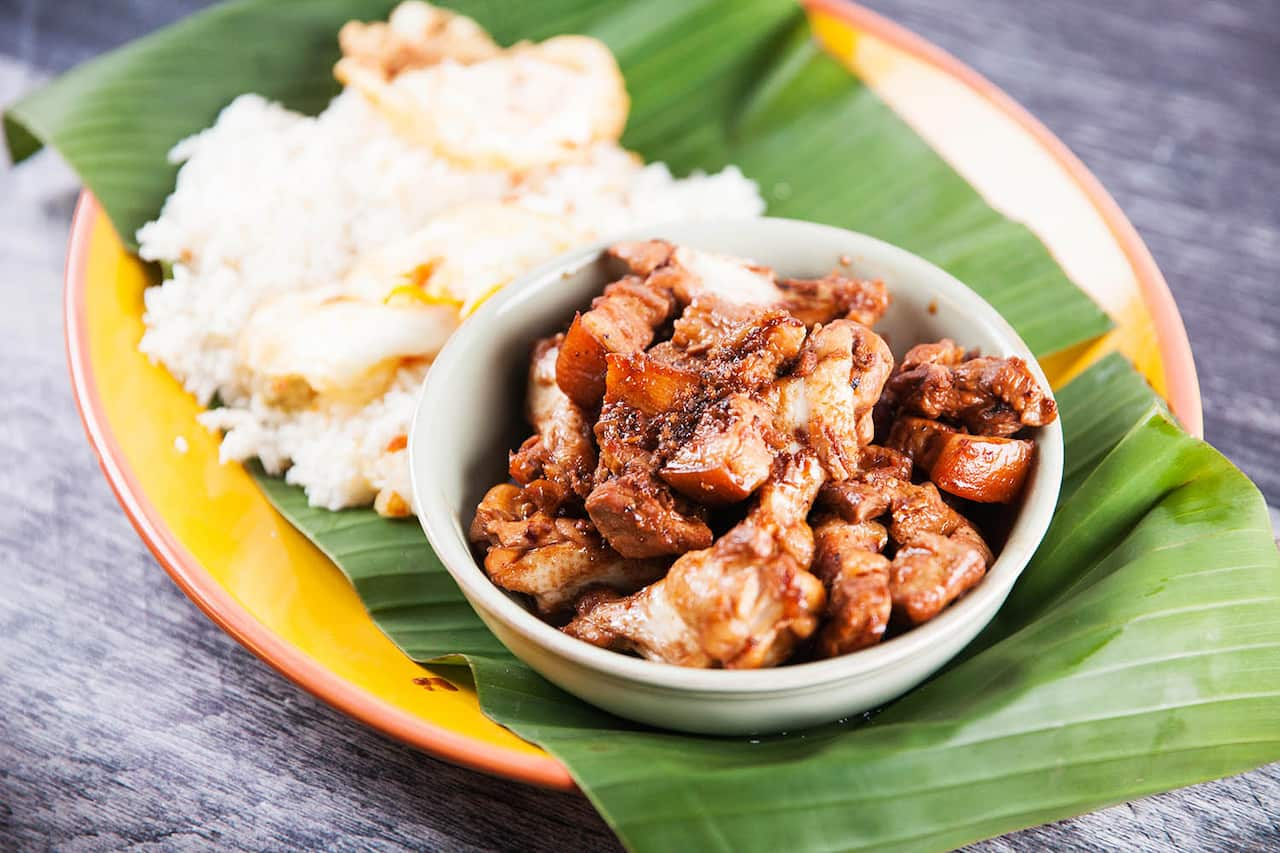Every Filipino household and Philippine province will claim that it has the best adobo recipe ever created. While there is no definite figure, some theorise that there could be more versions of the dish than there are islands in the Philippines ().
As the Philippines celebrates (month of the Filipino language) this August, let's have a look at some of the more common translations of the country's most popular dish.

Filipino pork and chicken adobo Source: Andrew Dorn
The wet and the dry
Typical adobo is a stew, consisting of chicken and/or pork, loads of garlic, bay leaves, black peppercorns, soy sauce and white vinegar. Some add sugar to give the dish a bit of sweetness.
However, people from the province of Bukidnon bring pinatuyong adobo (dried adobo) in jars when travelling to Cagayan de Oro. Travelling takes several days and drying the adobo will lessen the risk of spoilage during the trip.
Dried adobo starts with chicken sautéed with garlic, onions and ginger. Water, soy sauce, vinegar, pepper, and sometimes, lemongrass, are added. The concoction is simmered until all of the liquid evaporates.
The vinegary and the coconutty
Adobong puti (white adobo) does away with the soy sauce and consists of chicken and/or pork, vinegar, sugar, garlic, bay leaves and salt.
Other white or clear varieties of adobo see the addition of coconut. Adobo sa buko contains coconut juice, while coconut milk is added to adobo sa gata. The dish is beloved by the people of Bicol who sometimes add chilli to either dish for an extra kick.
The red and the yellow
Adobo Ilonggo or adobo sa atsuete is red because of the addition of annatto oil. Other atypical adobo ingredients used in the dish include tuba (coconut vinegar), brown or muscovado sugar, tomatoes and lemongrass. This dish is popular in Visayas and Southern Luzon.
On the other hand, turmeric gives adobong dilaw a yellow colour. While vinegar, garlic, sugar and onions are added, soy sauce is omitted from this peppery dish.

Chicken adobo: just one of many classic Filipino dishes worthy trying. Source: Benito Martin
The offal
Some cooks use canned liver spread to thicken their adobo sauce and to give it a richer, meatier flavour.
Others, however, seek out a deeper, more mineral flavour and either add or replace proteins in adobo with chicken offal and innards.
Adobong atay at puso ng manok (chicken liver and heart), adobong paa ng manok (chicken feet) and adobong balunbalunan (chicken gizzard) are some of the more popular offal adobo dishes around.

Some people say adobo is part of the trifecta of Filipino cooking. Source: Pilar Mitchell
The meatless
While the usual proteins used in adobo are chicken and pork, there are other varieties that focus on vegetables and seafood.
When it comes to seafood, adobong pusit (squid and squid ink), adobong hipon sa gata (shrimp adobo with coconut milk) and adobong isda (fish) are two of the more popular varieties.
Popular vegetable adobo dishes are adobong talong (eggplant), adobong kangkong (water spinach), adobong labong (bamboo shoots) and adobong mani (peanuts).
The flaked
One of the best ways to repurpose leftover adobo is to create crispy adobo flakes.
The sauce is set aside. The chicken meat is flaked and, along with slices of pork, fried in very hot oil. Once crispy, a bit of the sauce is either poured on top of the meat or served on the side. Like all adobo dishes, this version is best served with rice. Dry adobo flakes can also be cooked with garlic bits and white rice to create adobo fried rice or used as a filling in hot pandesal (bread rolls).
Dry adobo flakes can also be cooked with garlic bits and white rice to create adobo fried rice or used as a filling in hot pandesal (bread rolls).

The is from 7000 Islands by Yasmin Newman, published by Hardie Grant Books, (RRP $49.95).
NOTES ON FILIPINO FOOD

Ross Magnaye packs punchy Filipino flavours into this laneway eatery








